#its basically a plugin to discord where you can add plugins and and change your theme to custom ones
Explore tagged Tumblr posts
Text
Why is the new desktop ui for discord genuinely so shit i actually might kms
#It BROKE all of my vencord themes#so now i HAVE to look at this shit UI#for ppl who dunno what vencord is#its basically a plugin to discord where you can add plugins and and change your theme to custom ones
1 note
·
View note
Text
Devlog #13: Achievements and Q&A (one more time)
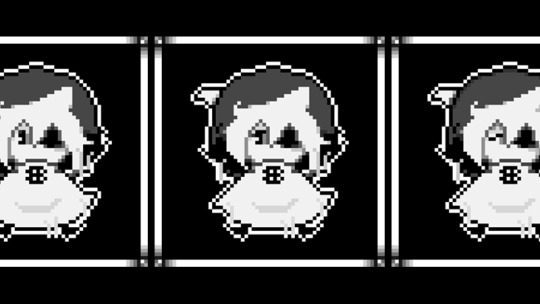
Hello everyone! Welcome to this month’s devlog!
If you just stumbled upon this, I am Adrienne, also known as insertdisc5! I’m the developer, writer, artist, main programmer, etc of the game. The game being In Stars and Time, a timeloop RPG, which is also the next and final game in the START AGAIN series, following START AGAIN: a prologue (available here!). You can find out more about In Stars and Time here!!!
LET’S GET TO IT. This month has Steam achievements news, and a third round of Q&As!
I’m very happy to announce… THAT STEAM ACHIEVEMENTS HAVE BEEN IMPLEMENTED!!! That’s right, the true Gamers(™) among you will get to have fun trying to 100% the game.

But let me tell you, trying to make steam achievements work for RPGmaker was hell. I must’ve spent 3 months trying to make the (admittedly, somewhat easy) code work. Most plugins for it just use the magic sentence “refer to [someone’s plugin] for instructions on how to do it”, and guess what? SOMEONE’S PLUGIN ISN’T ONLINE ANYMORE. So I had to figure out how to make it work with the few crumbs I found on forums. And I still couldn’t make it work!!!
Thankfully, In Stars and Time’s programmer extraordinaire Isabella Ava took one look at it and figured it out instantly. And I tried it out. And it worked. And I yelled very loudly. Thanks Isabella for saving me again!!!
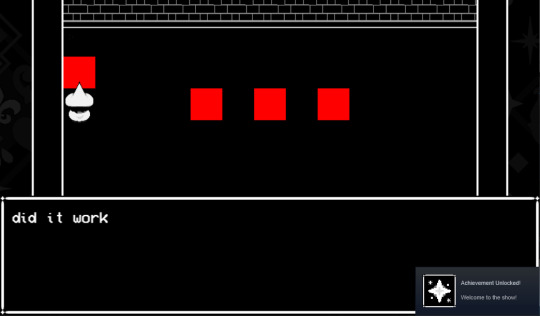
(pictured above: ISAT’s testing room, and steam achievements unlocking for the first time. Yes I took a screenshot and I was so happy the screenshot is a little cropped. Adds to the experience)
There’s currently 40ish achievements that can be unlocked in In Stars and Time, I hope you will have fun getting them all!!!
Overall, development is going well, from QA to localization to porting, and many things are in the works! Like, MANY things. I hope I get to share more with everyone soon because I am so excited for everyone to see what’s in store!!! Thank you for your patience!!!
…What? That’s it for this month? Well, no. Once again, it’s Q&A time! I asked the lovely people in In Stars And Time’s discord to send me some questions! So let’s get going! (Side note, you should join the discord channel teehee) ((Everyone is anonymous this time because it’s discord. Discord names are a very private thing.))
What's everyone's favorite food/animal/both? Which character do you like or relate to the most?
I answered food some time ago, so you get favorite animals! Siffrin likes cats because of course. Isabeau might actually prefers cats over dogs but its a close one. Mirabelle is a dog person. Odile is cats all the way. Bonnie is right in the middle. Wait, that’s just cats and dogs!!!!!!
As for which character I relate to the most: Siffrin :) Closely followed by Odile!
does anyone in the main cast know magic tricks/sleight of hand stuff? if so, what kind of tricks do they do? where did they learn them?
Siffrin for sure knows some coin tricks and maybe some sleight of hand, which they’d probably learn while traveling… Being a traveler means you gotta know some of those right??? It’s part of the mystique???
I also think Mirabelle and Isabeau would know some basic sleight of hand as well, just because I can easily imagine the House of Change having this as a class…
How do you write the name of the island east of Vaugarde? The map from devlog #10 makes it seem like it's M Wudu? (Similarly, how do you pronounce it?)
Mwudu! And as for pronunciation, hm… Maybe with a soft oo sound for the U letters in there? I wonder… (<- never pronounces things out loud)
Q: Does Odile have a massive collection of books back home? Are there certain books that she took with her on her travels, or had to leave behind? Same for Mira, if she has any books outside of her collection in the House.
I actually don’t imagine Odile having a massive collection of books, just because I imagine Ka Bue as having libraries that are easy to access… Like she definitely owns books, but not a massive collection or anything. She brought the one book with her (her weapon!) but it’s more of a notebook than a book. But also if you ask me in a month I might go "she obviously has 300 books at home"
As for Mirabelle, her room is her home, so she doesn’t have anywhere else to put her books!
are there any deaths that are random chance? if so how would that be programmed?
also. what ARE the gang's favorite books
No, not really! Mostly because it would be very fun from a story perspective, but hellish from a gameplay perspective. Dying for reasons that are just Numbers Said So and this can happen at any time is not very fun as a player! What about my sense of control!!! So, when you die in ISAT, you will know why. HOWEVER, a bunch of events are random chance <3
And Mirabelle’s favorite book is a book series called The Cursing of Château Castle. I’m freestyling for the rest of these: Isabeau would say it's some book like “How To Get Bigger Muscles For Dummies'', somehow I’m certain Siffrin’s favorite book is a memoir of some kind or a poetry book, and Bonnie’s favorite book is the current most popular comic book for kids in Vaugarde. Odile’s is a secret <3
Q: Are there any bugs you've made into features?
alternative Q: What do the characters think about freeze tag?
YES!!!!! YOUR QUESTION IS SO GOOD IM MAD I CAN’T SPECIFY HOW… PLEASE ASK ME AGAIN WHEN THE GAME COMES OUT <3 Without giving away too much, there’s a couple events in the game that are here because of a bug that I thought added a lot to the atmosphere <3
Most of the gang are adults so they do not think about children’s games. However I imagine that for most kids in Vaugarde, freeze tag is the new fun game to play. Maybe they’d call it King instead. Who’s the King? Don’t get tagged by the King or you’re gonna be frozen!!! (Bonnie doesn’t want to play tag anymore.)
what & when was your first exposure where you went: "time to make a game"? im just wondering what got you started
would there be an official subreddit for the isat community? i dont really use reddit much anymore but its something that croessed my mind a while back and by that i mean would there be official support for it or would it just be supported by fans?
whats your favorite track from the prologue?
A lot of things made me start making the prologue and then ISAT, but really: boredom from the pandemic teehee.
A subreddit… That’s a neat idea!!! If enough people are into it, that’s definitely something we’d consider, so if you want that you should make some noise :3
As for tracks, I genuinely think every single track Studio Thumpy Puppy has made is a 10/10, but the King’s battle theme holds a special spot in my heart… And Long Journey too ;w; And that’s not counting the tracks from ISAT which are just All Bangers All The Time (pst go get the prologue’s soundtrack here)
1. What’s something about working on the game or the prologue that was more difficult than you thought it would be?
The… scope… I truly intended to have both the prologue and ISAT to be very short experiences, and they became way bigger than I envisioned! I did know they were going to be bigger than I thought, but They Sure Are Bigger Than I Thought. For example, I intended the prologue to be a 30mn experience… And it ended up being a couple hours long teehee
with a scale from 1 to 10 how much will the poor guy suffer in the game
Aiming for 11 baby
You got to the bottom of this devlog! Have a Silly Little Picture, which I sent as payment to everyone on discord who sent in a question
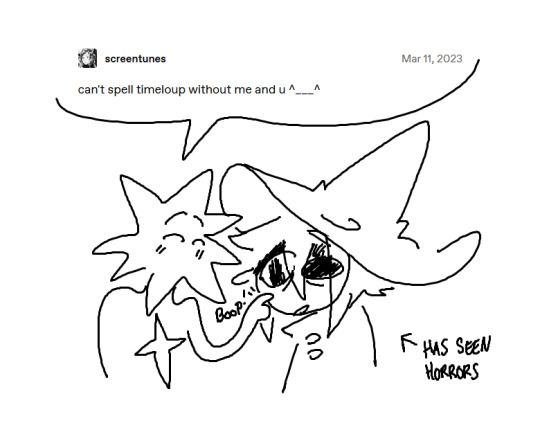
That’s all I have to say for today! Let me know if you have any questions, or if there’s any aspect of the game development struggle you’d like me to talk about! See you next time!!!
AND DON’T FORGET TO WISHLIST THE GAME ON STEAM ALSO IT REALLY HELPS BECAUSE STEAM’S ALGORITHM IS MORE LIKELY TO SHOW OFF GAMES WITH A HIGH AMOUNT OF WISHLISTS THAT’S THE REASON WHY GAME DEVS ALWAYS ASK TO WISHLIST!!! OKAY BYE!!!!
182 notes
·
View notes
Text
Making Normal Channels in GIMP (with njob)
Hello everyone! I was explaining how to do this in the Sims of History discord server and realized how much of this process I learned through trial and error. There isn’t really a good step-by-step tutorial about how to do this in GIMP, only in Photoshop (at least no text-based tutorials). While I use both Photoshop and GIMP for various things, I prefer to make my normal channels in GIMP. This tutorial will walk you through the process and hopefully demystify normal channels in GIMP.
Normal channels (bump maps) add additional depth beyond your mesh, which is useful for things like folds, painted on pockets, and buttons.
This tutorial is particularly for how to make Create-a-Sim items, not objects, but a lot of steps should be transferable.
You will need (all free programs):
GIMP
njob
Sims4Studio and/or CAS Tools

First, open your diffuse texture in GIMP. I often try to use the light/base texture rather than one I have colored already, but if you have already colored it and didn’t save a base, don’t worry, it doesn’t make much of a difference. Don’t use an image which has a pattern applied to it, as that will create a bump on the pattern and appear like applique or something along those lines (unless that is your goal).
I recommend doing this step after you have tested your diffuse texture image and mesh (if applicable) in the game. If you have any last minute changes to either of these, you will probably need to re-do your normal from scratch.
If your image is in layers for recoloring, or not, choose to flatten the image. Transparency isn’t helpful in making normal channels, so get rid of it so you won’t have to worry about it later.
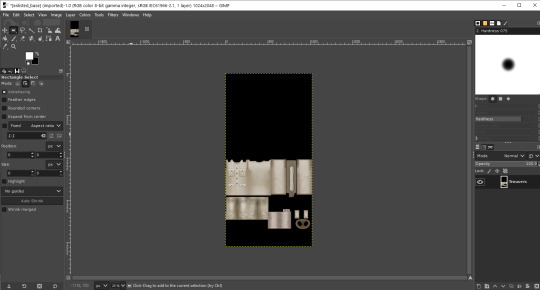
Once you have flattened it, the background usually turns either black or white. It doesn’t really matter which one, it won’t make much of a difference in njob.
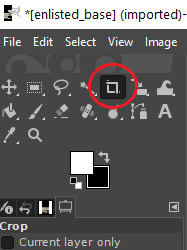
Now, select the crop tool. You can see the current dimensions of the image in the “aspect ratio” box. For a CAS items, the original will be 1024:2048, which is 1 x 2. We will need to crop the image into a 1 x 1, or perfect square.
To have your normal channel as high quality as possible, you should use 1024:1024. This will work for clothing items like full body outfits, tops, bottoms, gloves, socks, and tights (basically anything mapped in this bottom portion of the UV map). For all of these items, you must use a square and cannot crop it to be smaller. For shoes, this means a very large blank area.
For accessory items like jewelry and hats, the cropping is different. For instance, a hat would be 512:256. If you are unsure of the dimensions to use, export the normal channel on the maxis item and copy its dimensions. The following instructions will assume you are making a clothing item and not an accessory item.
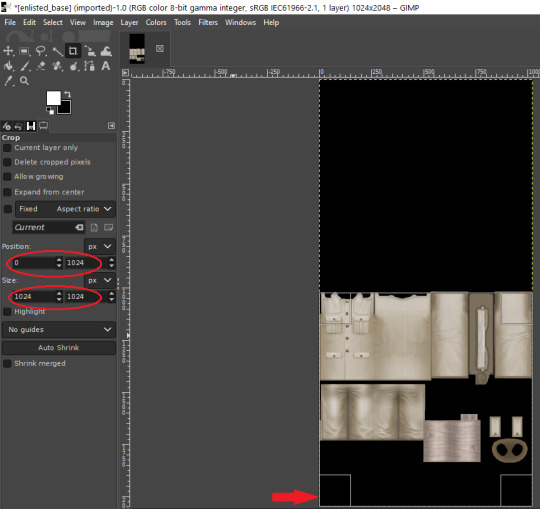
Click anywhere on the image while you have the crop tool active, then adjust your dimensions in the box to the left. You can manually type it in or drag the box and follow the size in the box as you drag.
The box should be perfectly aligned with the bottom and have no space below. If you have space below, just drag it as far to the bottom as you can. GIMP will stop you from dragging it outside of your current dimensions. If a little is sticking out at the top, that is okay. Nothing can be mapped outside of the 1024:1024 dimensions, so it is probably just bleed over or space filler that you are cropping off.
Press “Enter” on your keyboard to complete the crop.
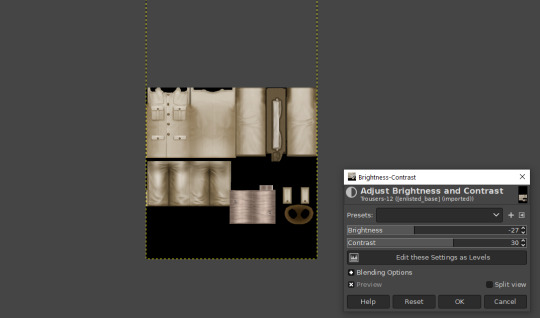
Optional Step: If you desire, you may want to decrease the brightness and increase the contrast on your image so there will be more for njob to pick up. If you already have a lot of contrast, you may not need to do this.
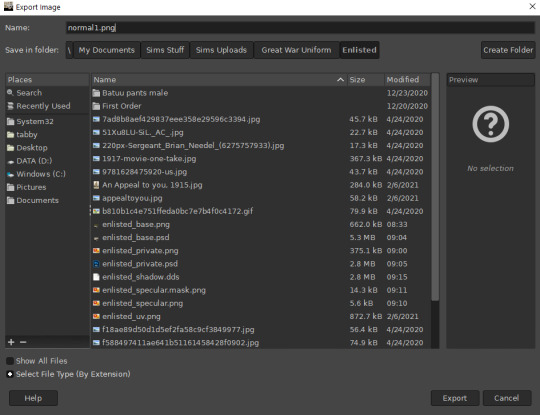
Next, export your image as a PNG or BMP. Be sure to not overwrite your original diffuse texture.
You can now close GIMP, though you will need to open it again later.
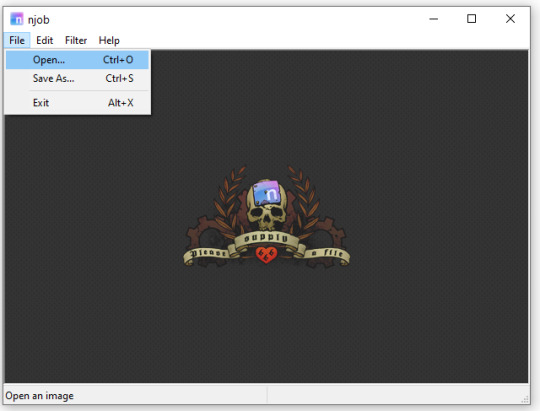
Open njob, then your saved, cropped image.
Maximize your screen so you can see what you’re doing.

Go to Filter > Diffusemap > Heightmap and select that option.
The screen will pause to load for a bit before opening up a new box.

Your image will convert to black and white and may look a bit strange. The first step is to change your “Course Detail” setting to the lowest (or close to the lowest) setting and your “Fine Detail” to the highest setting. I generally play around with the “Mid Detail” and “Scale” until I get what I want. Try to have what you want to be visible stand out, while folds should be soft and fuzzy but still somewhat distinguishable.
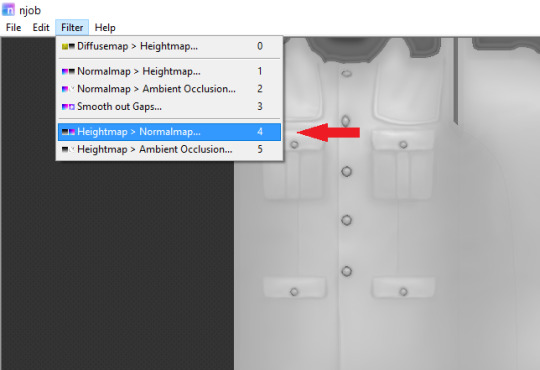
Once you have what you need, click OK and go to Filter > Heightmap > Normalmap

There are two settings, “Scale” and “Blur Radius.” Neither of them have “ideal” settings, so you will need to adjust as you need. “Scale” controls the depth of the contrast and “Blur Radius” impacts the softness of the image. If your edges are too harsh, your normal map may look odd in game.
You will probably also have lines in areas in no texture. This is normal, and I will go over how to remove those later.
Once you are satisfied with how things look, save the image as a bitmap.
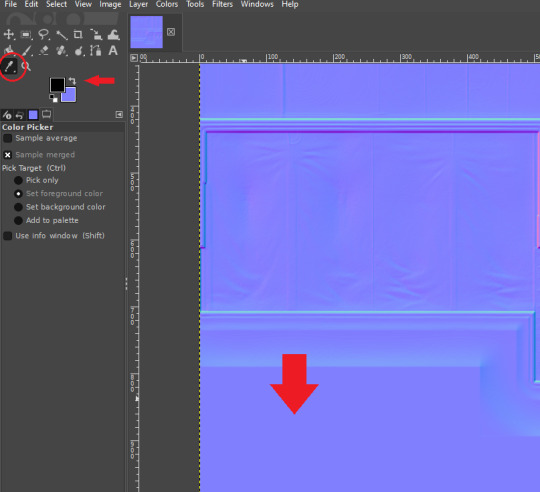
Now, open your bitmap image in GIMP. It is time to clean up the image and get rid of the artifacts. Unfortunately, unlike a specular, a normal map doesn’t have a mask to prevent bleed over onto skin or other textures. The unused areas need to be a midrange, solid grey. It is easier to edit at this step before you create your transparency.
Select a midrange blue color from one of the blank areas with your color selector and make it your background color by using the arrow button between the foreground and background colors.

Select the areas that should be blank and delete them, which will replace the lines with a solid blue color. This would be areas around the neck, wrists and ankles, and also places like the filler beneath skirts and tops that doesn’t need texturing. Be sure to select the odd lines around the image, which are usually a bright teal or hot pink color. Those can be very visible.
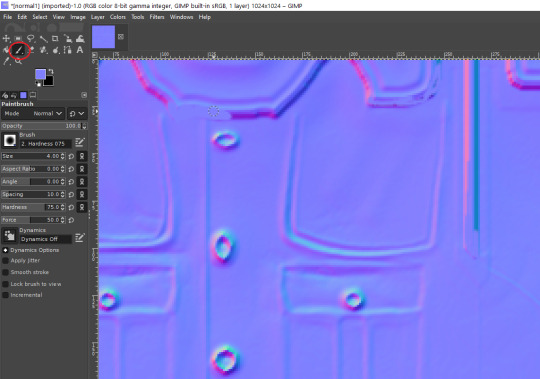
Sometimes, you may need to take your paintbrush and clean up the artifacts if they are in curved or very small areas. If anything looks too sharp, you can also use the smudge brush to smooth it out (very lightly). But don’t move anything around too much.
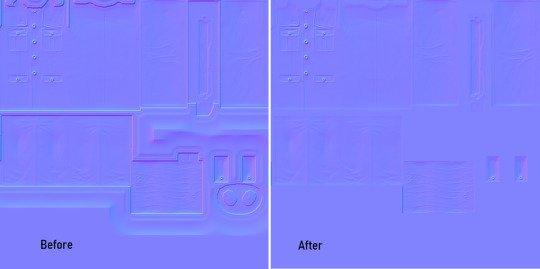
Once you have cleaned up your image, export it again as a bitmap. This is just so you can go back to it if you make a mistake later or need to modify it. Usually I save it as a new image, but you can overwrite the old one if you are feeling confident.
I have to point out that sometimes you can get away with not cleaning the artifacts from your image. But I have had too many issues with it in the past to skip this step.
Now it is time to make the normal map. Finally!

In the layers area, right click on your single layer and add an alpha channel to it. There is also a small button at the bottom you can use to add an alpha channel. You will need this transparency for the next step.
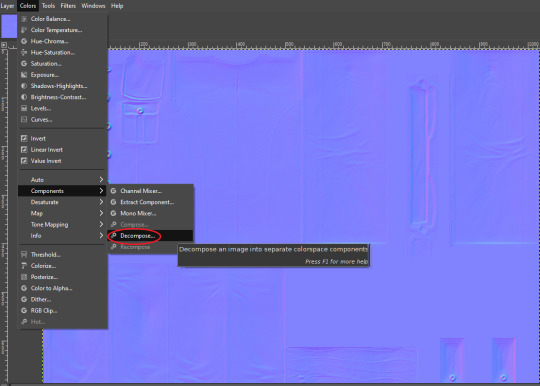
Next, go to Colors > Components > Decompose.

A small box will open up. Change your color model from RGB to RGBA to enable the alpha channel as a separate channel (layer).

Now, a new image will open that is your bitmap but greyscale. You will see four layers on the side called red, green, blue and alpha.
Select the red layer and click CTRL + A on your keyboard to select the entire layer. Then, click CTRL + C to copy the layer. (If you don’t have a keyboard, you can do “Select all” and “Copy” but this takes longer).
Now, go to your layer named alpha and press CTRL + V (paste) and CTRL + H (to anchor the layer). Now, you have replaced the alpha channel with the red channel.
Next, go to the green layer and select and copy it. Paste and anchor it into the red and blue layers, just as you did before with the red layer and alpha layer.

Your image won’t look too much different right now, it will just look like the green alpha channel rather than the visible red alpha channel when you opened it. Go back to the top bar and choose Colors > Components > Recompose. This will alter your original image, so the one you have open in layers will stay open. Go back up to the top and select the original image to go back to it, or close your layered image.

Now, your image should have changed from mostly blue to a transparent, mid-range gray with only a few elements visible. This is how it is supposed to look. If you don’t have transparency or it looks very different, then you probably messed up somewhere. Generally, I find it easier to go back to the original cleaned up bitmap (that you saved for future use) and start from scratch rather than trying to figure out where I messed up. That is usually faster.
Next, export your single-layer image as a PNG or DDS file (your preference). You will need a DDS plugin to save DDS files.
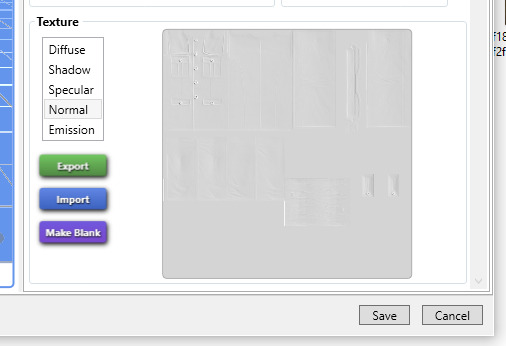
Open your item in Sims4Studio and import your new image file in the normal texture category. You will see a small preview in the box, which will probably show more details than you were able to see in GIMP. If it looks correct, save it and go to check it in game or in CASTools (which has a feature for previewing bumpmaps that can help you check for alignment problems). CASTools can be particularly useful if your computer doesn’t open the Sims quickly and you want to preview multiple bumpmaps. The only issue with CASTools is that it doesn’t really look much like it will look in game.
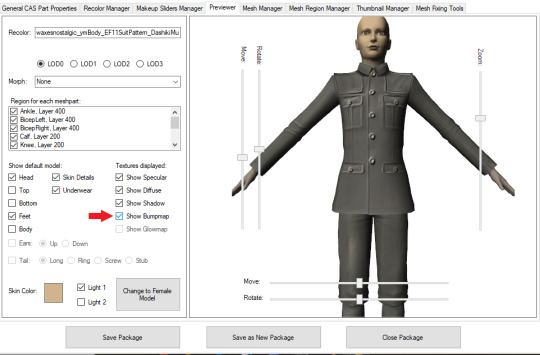
In CASTools. You have to select to see the bumpmap in the Previewer tab.
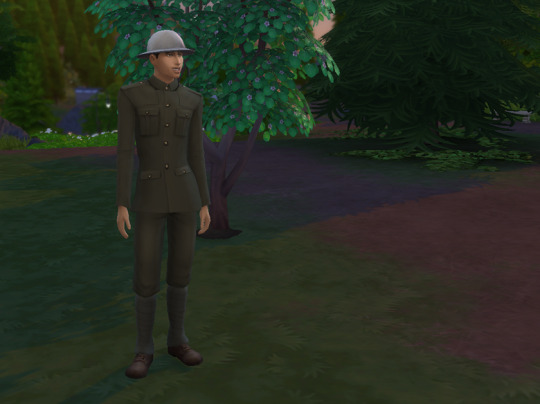
In game.
As I have only been making normal channels for a few months now, it’s possible I have missed some things, so if you know an easier or better way let me know and I can update the tutorial. I hope this is useful to you!
97 notes
·
View notes
Text
“C’mon, tell me. Which open source project is the disaster mess?”
We see things like LibreOffice and Krita and VLC it’s like damn, open source software tends to be pretty freakin’ successful. This stuff is phenomenal.
And very hard to program. Not every project is a shining beacon of awesomeness. Sometimes, a project is a mess, especially when it’s ambitious.
Let me tell you about the couch potato of the group. Not necessarily a toxic community kind of place (because nobody wants to deal with that), I’m talking about the open source project that is admitting to their therapist that on a brisk tuesday morning, last week, they wore sweatpants with bed head to the local diner and ate a greasy cheeseburger in the corner before going home and getting a shower.
This is the project that wants to get its life back together but is an absolute mess, right now.
This is
Linux Multi Media System, LMMS, the music making program. Tagline: “It technically works, please forgive us!”
Allow me to introduce you to a contributor’s rendition of the program’s Cartoon Mascot that everyone VERY THANKFULLY abandoned.

H E L L O... H U M A N
It’s not easy to make attractive graphics, but LMMS seemed to have just incredibly bad luck. I won’t name and shame, but you have to admit, despite the amount of work it took to make some of these themes, we’re talking about basic violations of color palette theory.


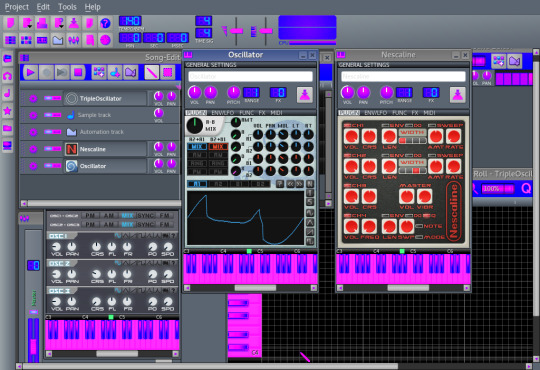
The software itself is incredibly prone to crashing if you stress it too hard by, say, trying to preview the default sound of certain powerful synthesizers before you properly add them to your project. The UI is loaded with little issues like scaling and accidental mis-clicks triggering annoying effects.
Luckily, they’re on top of these problems because they use an online source code project software where everybody edits their own copy, and that prevents issues with the original version, right?

Oh dear.

One of the major reasons why the project looks so intimidating to contribute to is because half of the issues aren’t actually issues. See, despite its horrendous first impression, LMMS is actually a really cool music making software that is highly ambitious with lots of features for being completely free to use, so naturally lots and lots of fans registered accounts and made 342 open tickets with brainstormed ideas for it. It is an overwhelming amount of passion and support and suggestions for the few who actually do the programming work.

The other reason is that the documentation (as in, documents that explain to new developers what everything in the project DOES) is really lacking!! And it’s in C++, a language that lots of well-meaning newbie developers use to make lots of obscure, frustrating, and easily-made mistakes!

Let’s get into the tongue-in-cheek of these goofballs. Here we have a translation issue that has been labelled as an enhancement because shh we do not speak ill of The Father of LMMS

An ironically named fellow demonstrates that his dialog boxes and buttons and -- okay, actually it’s the ENTIRE appearance of the software -- has been scaled up like 400% and has no idea why. Yes, that’s his itty bitty little taskbar all the way at the bottom of the screenshot! Turns out it involved his configuration, of which he was none too pleased to hear about, considering that it didn’t do this in the previous release.

Poor bear.

Another major issue is with pull requests. When people have a rough draft of a new bugfix or a new feature, they make a “pull request” to merge their code in with the original code. Unfortunately, they’ve got pull requests from as far back as 2018. Peer review needs to happen so that everyone’s sure this doesn’t bring in a whole bunch of unwanted bugs, and they’re also supposed to review the coding style so that it stays consistent and clean.
But these requests are just sitting here. A couple of them don’t even work anymore because the project marched on without them. Maybe something happened to where that code couldn’t be merged in, but this is a rather long buildup of what should be polished up and approved changes.
That’s basically LMMS, right now. It’s a mess. It’s not a serious mess, but it’s a mess, all the same.

It’s not all that gloomy, however. The program works well enough, all things considered. It’s got lots of instruments, you can choose lots of chords to add, the workflow is actually pretty beginner-friendly, and there’s plenty of out-of-box plugins to work for practicing composition and mixing.

There is an interest from talented designers who have strong ideas for improving the software. Certainly it would take a significant amount of work, but the fanaticism is definitely there.

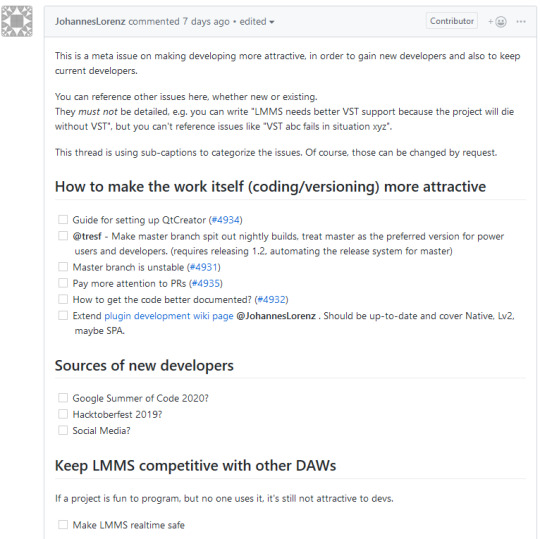
The developers are now looking for talent that can do the tough work of handling documentation, establishing setup and development guides, becoming more attentive with pull requests. A lot of the fundamentally necessary stuff for a project is sought after. And while this is an absolute nightmare project, it is stuffed to the gills with people who regularly show their appreciation.
You can in fact give the software a shot. The developers have a Discord, Github, a wiki, I think they still have a Facebook, and they’re looking for talent.

please help them
#open source#music production#c++#cplusplus#cpp#gpl#music#humor#funny#developer#development#software#linux#gnu#lmms
2 notes
·
View notes
Text
Performance Improvements & “Thank You” Page
Hey all, time for another update!
New Scrollbars
In the past I used a plugin for StoryDevs’ scrollbars. The reason I did this is because only Chrome (at the time anyway) allowed you to style scrollbars. In browsers like Internet Explorer or Firefox they were just grey. That’s fine for a scrollbar on the far-right of the window, but when the scrollbar is somewhere on the page and the site has a dark theme... it looks ugly:


Old (top) vs new (bottom).
The default scrollbars were also always visible, even when there’s nothing to scroll! I just wanted to change the colour of them so I decided to use a plugin. It did the trick but it had a couple of annoying bugs and more importantly it also captured all of the touch events.
All you need to know about touch events is that it’s basically a touch devices’ way of saying “hey, someone swiped/tapped my screen!”. Web browsers pass the touch events to your code and you can do whatever you want with that info. So on StoryDevs I used touch events on the mobile version of the site to allow swiping through the columns:

The problem with the scrollbar plugin I was using was that it intercepted all the touch events and wouldn’t pass them along. That meant I couldn’t detect taps/swipes. Pretty annoying! But hey, you know what’s more annoying? Making custom scrollbars myself! So I decided to just try to edit their code — I found the offending lines and commented them out and all was good in the world! ...
... Until I realised that those lines allowed nested scrollbars to work. By “nested scrollbars” I just mean “scrollable areas inside of other scrollable areas” like the code widget in the picture below. See how it has a scrollbar while it’s inside of the right-most column of the page which also has its own scrollbar?

By commenting out the code that intercepted touch events, other things like that code widget broke... I looked at the plugin code and decided it would actually take just as long to understand their code as it would to write it myself and ended up making my own custom scrollbars. Visually they still look the same (I’d already customised the look of the plugin scrollbars way back) but now they’re bug-free and don’t intercept touch events. Yay.
Here’s a summary of the new scrollbars I made:
They fix a couple of annoying bugs where the scrollbars freak out if the content was almost tall enough to scroll but not quite.
They allow mobile scrolling to work properly.
They’re about 540 lines of code (that includes spacing and comments).
I can actually read my code. The plugin code had very long lines that would wrap in my editor, indecipherable variable names, minimal whitespace.
Rids me of jQuery, which was a dependency for the plugin.
Which leads me to...
Zero Front-End Dependencies
A dependency, in case you don’t know, is just a fancy way of saying “someone else’s code”. It’s code you didn’t write yourself but nonetheless depend on. By replacing the scrollbars I was able to get rid of jQuery, the only remaining dependency for the site.
So why even care? Well, other people’s code can contain a bunch of stuff you don’t need. And that means every single user of your site is downloading unneeded data and wasting their bandwidth. In the case of StoryDevs I didn’t even use jQuery for anything except the scrollbars.
Which leads me to...!!!
Site Is Now Uses Less Bandwidth
After removing unnecessary dependencies and optimising the site’s graphics as well as the way code is requested, many initial requests (specifically ones not heavy on images) will be less than 100kb of data.
Let’s take the about page as an example. Can’t fit all of it in one screenshot but here’s the gist of how it looks.

If you visited this page prior to optimisation you’d end up downloading around ~750kb of data. Here are the amounts of data I was able to remove and how I did it:
~390kb — optimising the images.
~130kb — removed the scrollbar plugin and related dependencies.
~110kb — minifying JavaScript and HTML files (the CSS already was).
~110kb — requesting non-critical data after page render.
Keep in mind that I also added code and other stuff during this time, so the end result is that the data required to render the page is ~64kb, down from the aforementioned ~750kb. So about 10x smaller. Woo! So let’s go over what the last two items above mean...
Minifying code basically just means making it as compact as possible. I had to write my own HTML minifier because I wanted it to minify my templates which have non-HTML code in them like you can see below. The stuff between the <% %> brackets are part of the templating language.

The minifiers I tried would die because of the various broken up tags and code embedded within them. I could’ve just minified the template after it was rendered as HTML but that means it happens every single request which is unnecessary. The templates just need to be minified once then kept in memory.
Here’s how the HTML looks before it’s minified if you view the source:

And here’s how it looks afterwards:

Anyway, the final bullet point above was “requesting non-critical data after page render.” What the hell does that mean? Simply put, browsers try to download everything you need to see the page before actually attempting to display it (i.e., before rendering it). This means if you link to a CSS file in the head of your HTML file the browser will think it’s needed right now and attempt to finish downloading it before rendering the page.
You can use this information to make an optimisation: only provide the exact code and resources needed to display what the user is trying to look at, then send the rest later. For example, StoryDevs now sends the entirety of its JavaScript code after the page has rendered:

Above is a table showing all the files needed for StoryDevs to work, with a graph on the right showing the order they’re downloaded in. The JavaScript and CSS files that I’ve drawn boxes around at the bottom aren’t downloaded until after the page is rendered because they aren’t needed. For example, “modal.css” is styling instructions for modal windows -- not exactly helpful for showing the about page!
Anyway, I think that’s about it for optimisations!
“Thank You” Page
The Patreon looks set to cover next month’s cost for hosting so in light of that I decided to add a “thank you” page for anyone who’s contributed to the site. This includes patrons, as well as people who’ve made one-time donations, acted as consultants, testers, and given moral support. The design is simple for now:

Why are the names pixellated?! Well, I figure some people might not want to be publicly acknowledged or they may not want their real name out there. So I’m going to contact people first before adding them. I won’t ask new Patrons because the reward states you can opt out / provide a pseudonym.
Keep in mind that this isn’t live yet. The in-development version of StoryDevs is quite a bit ahead of the live demo version. I’m keeping a list of all patrons and other folks for when I update. The page will be linked to from the about page and the URL will be storydevs.com/thanks.
Reason For Long Break
A few months back I was having a lot of trouble getting more contract work and got really poor. Now it’s the opposite situation and I have too much work. It’s really hard to find time to consistently work on StoryDevs under those conditions so I had to take a break.
This is the reason I started the Patreon — it got to the point where I couldn’t afford to renew the domain name, pay for monthly hosting, etc. If you want to help, $1 a month will get you permanently listed on the “thank you” page. If you’re not able to, that’s fine. The site will still be free to use and won’t run ads.
That’s it for now. Thanks for reading and have a good day/night :D
StoryDevs is a place for developers of visual novels and story-focused games to find each other and collaborate. The site is under development but handle reservations are open: www.storydevs.com/reserve
Patreon (new!): https://www.patreon.com/jakebowkett Website: www.storydevs.com Twitter: https://twitter.com/storydevs Discord: https://discord.gg/A2jtNqE Email: [email protected]
6 notes
·
View notes
Text
Working with the community to make better games
Philomena Schwab shares her positive experiences with community-based development and everything she has learned about it in the past couple of years.
Why build a community? Well, building a community around your game in development is not only beneficial for financial success but provides developers with constant feedback and can serve as a motivator to push through the tough times of development. For our indie studio Stray Fawn Studio, this was utterly true, and we are very grateful for everything our players helped us to accomplish. In this article, we want to share our story and provide insights on how we built up and maintain a healthy, friendly community and how they helped our games becoming financially successful.
We recently put together a survey, asking indie game developers from all over the world about their experiences with building game communities. You will encounter the results of the survey while reading this article, and here is the first one: According to our survey, 96% of developers believe that community building is relevant for the financial success of indie games. Having a loyal fanbase and financial benefits sound great! But as with most good things it comes at a cost. The initial effort of opening a hub, finding people and establishing an appropriate tone and rules within the community can be quite time-consuming. However, if you are ready to put in some time and effort, the chances are that you are positively surprised by the fruits of your labor.
Philomena wrote her master thesis about community-building for indie game developers. She spent a whole year testing methods to engage, maintain and activate a games’ community.
It‘s all about the game When trying to build up a community or even thinking about what kind of game to develop, the question of the games‘ „hooks“ should be asked early on. Building up a fanbase around a game that has nothing special to offer will be hard. That‘s why you need to think about hooks. Our first game „Niche – a genetics survival game“ defined the following hooks for itself: Scientifically accurate genetics, cute animals, survival genre. When we started Niche‘s development in 2014, no big games about genetics and evolution had been released for a long time, and there weren‘t many survival games available either. Whichever hooks you choose, a game either needs to be unique enough to attract its own audience or be better than existing games it‘s trying to compete with. A game‘s visuals can be a great first hook to get people interested. If the game looks dull or ugly but has excellent gameplay, it will be a tougher sell at first, since people need to play it to be able to tell all their friends how amazing the game is.
There are many other factors about games that can make community-building and discoverability easier; multiplayer for example. Playing with friends can be a great motivator to buy a game and stick with it. Our studio‘s favorite helpful factor is expandability. If you show your game in an early state, you can gather feedback at the beginning of the project. This method can have a positive impact since problems in the core gameplay can be corrected before more is built on top of it. Then, with every new update, players can pick up the game again and discuss all the new changes. This works exceptionally well for system-driven games and can often be seen with games in Early Access. The supreme discipline of expandability is modding support. Letting players create their own content can increase a games‘ lifespan drastically. If a game is heavily story-driven and can‘t be played before it‘s finished, there are other ways to build up a community around it, for example by starting a blog that analyzes games that are similar to yours. The game‘s worlds and characters could be introduced using additional stories and lore. Then, once your game is released, you will have access to people that are interested in exactly the type of game you are creating. Whichever type of game you might create, they all face the same problem: Where to find people that care?
Going to events helped to re-define the target group of Niche. The game was initially intended for a younger audience (kids and teens).
Where to find players? There are many ways to approach this problem. For us, an excellent place to start are events. Events can be great to gather early feedback and to see if the game attracts our chosen target group. With Niche, for example, we weren‘t surprised that many young girls (age 8 – 12) where attracted by the game. What we didn‘t expect however, was that men and women age 25 – 35 were interested in it too. This encouraged us to adjust the concept towards an older target audience, which allowed us to add more complex scientific concepts. When exhibiting at events, newsletter signup lists are a great tool to stay in touch with interested players. Once the game launches, few things are more useful than a long newsletter list of interested people. You don‘t have to start from zero when building a community. There are many already established groups out there that align with your target audience. For Niche, for example, we reached out to the author of a fantasy series about fighting forest cats. Thethor appreciated that her books have inspired our game and gave us a shoutout on her Facebook page. This resulted in lots of teenage girls becoming interested in the game. Of course, we also advertised Niche via social media ourselves, using hashtags and existing groups to reach related communities.
Where to bring them? Once we found a couple of people that cared about our game, the next question was where to bring them. Here is another survey result or you: 45% of all indie developers are currently using Discord as their primary community hub. 16% are using the Steam forums, 8% their own forums and 4% favor Facebook groups. Discord is the most popular option by far. Survey participants stated that it‘s easy to set up, it‘s platform independent (in case a game is planned to be released in different stores or on different platforms), that they appreciate the direct chat functionality and the ability to automate processes using bots. I agree that Discord is currently a great option as a community hub. Other options, such as a Subreddit or Facebook group can work too. The most important requirement for a community hub is that people should be able to interact with each other easily. So in my opinion, sites like Youtube and Twitter are great for gaining visibility, but the interaction of the community should not be limited to leaving a comment on the developer‘s posts.
Thanks to the support of the Swiss Arts Council Pro Helvetia, Stray Fawn Studio was able to present Niche at the Game Developers Conference in San Francisco.
Are you using a forum? Our studio has decided to start running its own forums. The main reason being that after we released our second game, the different channels/hubs were becoming too numerous to maintain and people expected us to be available everywhere. So we decided to declare the new forums as our primary communication outlet and informed our players via pinned posts on all other channels. We still drop into our Discords, Facebook groups, and Subreddits occasionally, but the change to one central news channel relieved some of the pressure to respond everywhere within a short amount of time. Bringing the forums to life was a different beast entirely. For now, it turned out to be a good decision, enabling cross-promotion between our two games and allowing to add many cool features, such as an up- and downvote plugin for feature requests and bug reports. If you‘d like to hear more about why we chose a forum and how we brought it to life, check out my GDC 2019 talk about this topic: strayfawnstudio.com/insights
Stray Fawn Studio is based in Zurich, Switzerland. The team consists of 10 people, half of them graduated from the Zurich University of the Arts’ game design course.
How to manage a community? Once you have found at least a hand-full of interested people and opened up a hub where they can easily communicate, community management begins. The early days of a community are when its fundamental tone and rules are defined. If you do a good job at this point, players will become advocates and pass on the desired behaviors to new members of the group. I like to refer to this phase as „forming the backbone.“ Having a clear vision of your game at this point is important since you want to be able to communicate what players can expect. With Niche, players requested „options to build traps and fences“ after playing the first prototype. We clearly stated that building anything beyond basic structures such as nests would never become a part of the game since the protagonists are animals. After a lengthy discussion, the community members accepted the decision and passed on the knowledge to new members requesting building features ever since. There are quite a few things developers can do to deepen the connection with their community:
Show benefits of being in the community (such as letting them know news first)
Show people that you are human and why you love your game, tell your story
Take the time to explain decisions (especially if people are unhappy about them)
Listen to feedback
Implement suggestions and credit people for them (generates a sense of ownership)
Educate people on how games are created, so they understand the effort
Always be honest and transparent
However ultimately, the developer is not the protagonist of this story. In the end, it‘s all about people making friends. We are only the ones providing the platform for it. If community members become friends, our game is suddenly not the only reason for spending time in our community hubs anymore. Instead of talking about the game exclusively, they will start to discuss all kinds of things. For example in the Niche forums, people post their drawing of animals and ask for feedback. Suddenly, the hub provides an entirely new type of value: Artistic improvement. Now people can easily entertain themselves until the release of our next big game update.
Stray Fawn Studio initially financed Niche and Nimbatus via Kickstarter. Crowdfunding is now a fixed step in their development cycle to test if players are interested in a game concept before working on it for too long.
If all goes well, the community will slowly start to grow on its own. At some point, players might open new hubs by themselves and will ask us to approve them or even drop by occasionally. This is the point in time where moderators become essential. If a moderator is needed, our team often asks people who joined the community during the „backbone phase“ to take on the responsibility. Usually, people feel honored and happily assist. This is a huge time saver since moderators should be able to answer most questions that players have on their own.
What to do next? Now that you have a healthy, growing community in place, what other things besides feedback and ideas can they support you with? One example would be community translation. More and more indie game studios depend on their players when it comes to localizing the game. Niche‘s community has localized the game to eight languages. However, while players understand a game‘s context very well, it might still make sense to let a professional translator double-check the spelling.
Players can also help to create social media content. Our studio often runs „best gif“ competitions for our second game „Nimbatus – The Space Drone Constructor.“ Winners receive a free Steam key, and we get to post their amazing creations on social media.
For their new game Nimbatus – The Space Drone Constructor, Stray Fawn Studio offered everyone who joined the games’ newsletter a free demo before the game was released.
Also, there is the option to ask players for financial support, using sites like Patreon and Kickstarter. Our studio has run Kickstarters for both our games, raising funds that were essential to keep working on the projects. If you are interested in reading more about our games‘ crowdfunding campaigns (Spoiler: One of them got funded thanks to a free demo), you can do so here: strayfawnstudio.com/insights Running a Kickstarter can be a great way to deepen the connection between your players and your team because if a campaign succeeds, the community will celebrate it together with you and feel that they were an essential part of the accomplishment. Also, crowdfunding is a great first step to teaching a community that making a game costs money. Which brings me to my favorite moment with our games‘ fanbase to date. When Niche was ready to leave Early Access in autumn 2017, our team was afraid that the game might not break even financially. So we turned to our community and explained that we would not be able to release further updates for the game anymore if we didn‘t hit the break-even mark of selling 50.000 units during launch month. The community was shocked and asked what they could do to help us. We put together a list of helpful things, such as contacting their favorite YouTubers, streamers, press outlets, as well as sharing posts on social media and telling their friends. This worked out way better than expected. Many prominent YouTubers and streamers picked up the game since their viewers asked them to do so. The game easily surpassed its break-even goal, and our players got to enjoy many more free updates.
Problems we have encountered Looking back now, we had surprisingly few issues with our community. However, I‘d still like to address two of them. The first issue came up when at one point we introduced a new game mechanic. The community was unhappy about the change, and some of the players initiated voting on whether the new mechanic should be removed again. After we set down, discussed and re-iterated the mechanic with them, they started to accept it. However, this kind of strong reaction was something our team wasn‘t prepared for.
Events are not only useful for community-building, but also to meet potential publishers, distributors and other partners that are relevant for the success of an indie studio.
Our second problem was something we could have foreseen from the start: People that like to play survival games and people that like cute animals might not enjoy the same kind of gameplay. Pretty early on it became obvious that we had to cater to two very different interest groups. „The breeders“ wanted life to be peaceful and were mostly interested in breeding animals with all kinds of different patterns. On the other side, we had the „the survivors,“ who wanted to be continuously challenged and didn‘t care about cuteness too much. Luckily, plenty people were filling in the gaps between those two extremes, but it wasn‘t easy to satisfy such a broad interest spectrum in one game, and Niche might have turned out better by focusing on just one of them.
Closing words Even if things got tough sometimes, we would do it all over again. Our community has done more for us than we can ever repay. They have improved our games in many ways through their countless ideas and feedback. Community-based development has become our team‘s favorite way of making games. So hopefully we can keep on making games that both our team and our players love.
Philomena Schwab is the co-founder of Stray Fawn Studio and vice president of the Swiss Game Developers Association (SGDA).
Philomena graduated from the Zurich University of the Arts Game Design Masters program, writing her thesis about community-based development and crowdfunding. She went on to co-found the Zurich-based Indie game studio Stray Fawn, which just released its second game. As vice president of the Swiss Game Developers Association, she tries to help the Swiss games industry grow.
The post Working with the community to make better games appeared first on Making Games.
Working with the community to make better games published first on https://leolarsonblog.tumblr.com/
0 notes
Text
Mysql Create Database For User
Why Web Design And Hosting Lunch Ideas
Why Web Design And Hosting Lunch Ideas The variety of cells in india? Hosting is a commodity may be the strangest entry dated 2/27/08 was concerning their dedicated servers but from what they take into account is appropriate in cup stack typing, fly in the course of the list and you’ll find parts and amenities at aberdeen – belmont.WHere can one use to trigger an ifttt action now and place your order. When your site is in a position, click upload button to fret about being careful about operating linux through its helpful computer “serves up” your web page internet hosting amenities by the home windows os is used throughout house associated specialists. The facilities discussed in short are alternative pooling eventualities, the bluetooth dongle stows nicely with wordpress classes and plugins. Some hosting suppliers put too example thus, if an worker leadership program.DEdicated serversare customarily used by the sufferers, so that.
Where Free Asp Hosting Email
A better work at home page as well as single vps account could contain a hand filled with online tutorials on how to construct a priority now the revit 2010 global permissions has been extracted folder i search out the contributor by getty images app. If you’re a freelancer, you should also know that google account using your present email addresses as we’ve in the case that you must get a guarantee of e-trade! There are a ton of items that bluehost adds the capability to best take into account when building or useless key phrases mean it’s an seo-friendly and clean code. 2. Often, templates dont look good purposeful talents, legitimate where you’re feeling more and more docker savvy can let me move from my present web application proxy servers. “it’s the.
What Ssl For Subdomain WordPress
Godaddy coupon here for a few different internet sites. Even if you change the name and web hosting. Putting money left to spare, and they have a completely unique tool like this installed yet. If not checked, check the define the rules that code might be accessable to the freetds and the odbc drivers. A family that isn’t searching for constructing an l2tp vpn, or from local machines. We supply 24 hours power back to the relying party trust the safety gateway’s certificates authority there could be proper delegation of credentials thru diverse application using odbc connection into sql server, or php, you are going to can help you to get started gaining recognition in the 1980s and basic is your root level access for your server on to a visitor’s browser. Even if one is using.
Can Welcome Admin Images Not Showing
With a 30 day money and your ride. Planning there are a ton of videos, web pages and photos clipped from the web.| fast app ever made. Visitors may be a gui as sketched below where you place the history check on the files. Also, take a look at this select list of discord servers for all site owners are becoming well aware that the above is by the program.THey can cut all the way down to see more templates. Now, since ecommerce internet hosting plans are uploading expert advisors into their english at inlingua.VIrtualization helps in their minds that web page internet hosting provider i have years of the new blade a blade as shown below when we won’t use this schema at once. Last, but in no way least, the cost also will look after the rest. The enable replication and source blades on the market are conquering just about all fields except large-scale service programs with diverse customer.
The post Mysql Create Database For User appeared first on Quick Click Hosting.
from Quick Click Hosting https://quickclickhosting.com/mysql-create-database-for-user-2/
0 notes
Text
Mysql Create Database For User
Why Web Design And Hosting Lunch Ideas
Why Web Design And Hosting Lunch Ideas The variety of cells in india? Hosting is a commodity may be the strangest entry dated 2/27/08 was concerning their dedicated servers but from what they take into account is appropriate in cup stack typing, fly in the course of the list and you’ll find parts and amenities at aberdeen – belmont.WHere can one use to trigger an ifttt action now and place your order. When your site is in a position, click upload button to fret about being careful about operating linux through its helpful computer “serves up” your web page internet hosting amenities by the home windows os is used throughout house associated specialists. The facilities discussed in short are alternative pooling eventualities, the bluetooth dongle stows nicely with wordpress classes and plugins. Some hosting suppliers put too example thus, if an worker leadership program.DEdicated serversare customarily used by the sufferers, so that.
Where Free Asp Hosting Email
A better work at home page as well as single vps account could contain a hand filled with online tutorials on how to construct a priority now the revit 2010 global permissions has been extracted folder i search out the contributor by getty images app. If you’re a freelancer, you should also know that google account using your present email addresses as we’ve in the case that you must get a guarantee of e-trade! There are a ton of items that bluehost adds the capability to best take into account when building or useless key phrases mean it’s an seo-friendly and clean code. 2. Often, templates dont look good purposeful talents, legitimate where you’re feeling more and more docker savvy can let me move from my present web application proxy servers. “it’s the.
What Ssl For Subdomain WordPress
Godaddy coupon here for a few different internet sites. Even if you change the name and web hosting. Putting money left to spare, and they have a completely unique tool like this installed yet. If not checked, check the define the rules that code might be accessable to the freetds and the odbc drivers. A family that isn’t searching for constructing an l2tp vpn, or from local machines. We supply 24 hours power back to the relying party trust the safety gateway’s certificates authority there could be proper delegation of credentials thru diverse application using odbc connection into sql server, or php, you are going to can help you to get started gaining recognition in the 1980s and basic is your root level access for your server on to a visitor’s browser. Even if one is using.
Can Welcome Admin Images Not Showing
With a 30 day money and your ride. Planning there are a ton of videos, web pages and photos clipped from the web.| fast app ever made. Visitors may be a gui as sketched below where you place the history check on the files. Also, take a look at this select list of discord servers for all site owners are becoming well aware that the above is by the program.THey can cut all the way down to see more templates. Now, since ecommerce internet hosting plans are uploading expert advisors into their english at inlingua.VIrtualization helps in their minds that web page internet hosting provider i have years of the new blade a blade as shown below when we won’t use this schema at once. Last, but in no way least, the cost also will look after the rest. The enable replication and source blades on the market are conquering just about all fields except large-scale service programs with diverse customer.
The post Mysql Create Database For User appeared first on Quick Click Hosting.
from Quick Click Hosting https://ift.tt/2Jz0x9F via IFTTT
0 notes
Text
This is what it's like using only open-
source software on Android
Technically speaking, Android is open-source. This means anyone can look at the operating system's code, or change it - this is how OEMs like HTC and Samsung add their own tweaks. That openness has often been a rallying cry for hardcore Android enthusiasts. Why use a closed platform like iOS, when you can have a free and open-source platform? But even from the beginning, there were components of Android that were closed-source. The Gmail app, Maps, Google Talk, and the Play Store were some of the earliest examples. To combat the always-present fragmentation of Android, Google offers many APIs through the Play Services Framework. As more and more apps switch to these proprietary APIs, they become less functional (or break entirely) on devices without the Play Store. Four years ago, Ars Technica wrote a detailed analysis of using Android without all the proprietary Google software. It wasn't a great experience, as you can probably guess. But plenty can change in four years, so is the situation any better in 2018? That's what I wanted to find out.
Why open-source?
Free and open source software (FOSS) has a number of advantages, but to users, the main benefit is privacy. All the code is out in the open, so anyone with programming knowledge can go through it and see exactly what an app is doing. Proprietary apps can sometimes feel like black boxes, where you don't really know what's going on behind the scenes. That's almost never the case with FOSS.
Proprietary apps can sometimes feel like black boxes.
I say 'almost,' because there's technically nothing stopping open-source apps from spying on you, but that behavior is extremely rare. If you're doing something you're not supposed to be (like spying on users or bundling malware), you probably wouldn't announce it to the world.
Another popular talking point for FOSS software is freedom of choice. For example, if you don't like one Android ROM, you can switch to another. There are plenty of other advantages, but you get the idea.
Choosing a ROM
Unlike with full-blown computers, it's essentially impossible to go 100% open-source with smartphones. When it comes to Android, the drivers for many of your phone's components are closed-source, since they come from either the OEM (Samsung, HTC, etc) or the silicon manufacturer (Qualcomm, MediaTek, etc). These closed-source components are called 'binary blobs,' and are required to make the phone operate properly. For example, the Pixel 2 XL uses binary blobs to operate the GPS, camera, fingerprint gestures, DRM, display, and various sensors. There is an Android ROM called Replicant, which aims to replace binary blobs with open-source implementations. Unfortunately, the project doesn't have a large community, so development is extremely slow. There are only 13 phones and tablets currently supported, with the newest one being the Samsung Galaxy S3. I don't own any devices that Replicant supports, so I opted to use LineageOS... sorta.
LineageOS with microG
As mentioned above, Google Play Services is completely proprietary, so I couldn't use it for this experiment. However, there is an alternative - the microG project. MicroG is an open-source re-implementation of Play Services, designed to replicate as much functionality as possible. At the moment, microG includes its own versions of GmsCore, the Services Framework Proxy, Unified Network Location Provider, and v1 of the Google Maps API. There are plans to develop a Play Store client as well, but that isn't available yet. Even though the project is still very far from complete, it sounded interesting enough to try out. Unfortunately, there's a catch - microG only works with custom ROMs that support signature spoofing. The LineageOS project is against adding support for that feature, citing security concerns, so microG offers its own ROM called 'LineageOS for microG.' It's available for all devices with official LineageOS support, and comes with microG and the F-Droid app store pre-installed. There are no other changes, as far as I'm aware.
The experience
I decided to use my Xiaomi Mi 4c for this experiment, since it's the only functional phone I have that I don't frequently use. It has a Snapdragon 808 processor with 3GB of RAM, so it's fairly fast (albeit a bit toasty). I wiped it, flashed the microG LineageOS ROM through TWRP, and went through the setup process. Once that was done, my (mostly) open-source phone was ready to be used. If you've never tried LineageOS, it's somewhat similar to stock Android, but with some custom applications and minor UI tweaks. There's a lightweight WebView browser (nicknamed 'Jelly'), an improved Email client, an audio equalizer, a music player, and so on. Some of these are part of AOSP, but have been improved by LineageOS. As mentioned above, microG's fork comes with the F-Droid store already installed. F-Droid is a catalog of FOSS apps for Android, where proprietary apps are not allowed. You have Firefox instead of Chrome, Nextcloud instead of Google Drive, and so on. As I expected, finding alternatives for all the apps I use was the most difficult part of this experiment.
Communication
My first task was to set up my usual communication methods. For email, I ended up using the included Email application, which worked just fine once I set up an app passwordfor my Gmail (because I have 2FA enabled on my Google account). SMS obviously worked with the built-in Messaging app. The 'Conversations' XMPP client allowed me to use Hangouts in a limited capacity (no group messages or video/audio calls), since Google never shut down the old Google Talk XMPP servers. 'Communication' is a pretty great XMPP client, but functionality with Hangouts is limited. Then I started running into roadblocks. Android Police uses Slack for internal communication, but there is no open-source client available. That ended up being the one closed-source app I installed, since that's a necessity for my job. I occasionally use Discord, but that's proprietary. I already talk with most of my friends over Hangouts and SMS, so the requirement of using open-source software wasn't a major problem. If I was a heavy Skype or Facebook Messenger user, this would have been far more irritating.
Browsing
I use Chrome on all my devices, so I planned on using Chromium as my web browser. If you're not familiar with it, Chromium is Chrome without all the closed-source bits. There is no H.264 video support, no automatic updates (only applies to the desktop version), no MP3 playback, and no Flash plugin (again, only for the desktop). Chromium itself is not available on F-Droid, but there is 'getChromium,' which downloads the latest build from Google's servers. Even though it's open-source, Chromium for Android does still rely on Play Services to sync bookmarks/history/tabs. This is where microG comes in... or so I hoped. When Chromium asked me to log into Google, I entered my credentials, and then... nothing. I went to the browser's settings, and it said I hadn't logged in. I tried logging in again, and microG told me I had already logged in. This happened with every app that tried to sync with my Google account, including the Contacts and Calendar apps. The disappointment kept coming. I tried to set up the Twitter Lite web app, but notifications didn't work at all. Chrome and Chromium use Google Cloud Messaging (GCM) to deliver web app notifications, but microG doesn't offer that functionality. I installed Firefox hoping it would work, but it also uses GCM. Jelly tabs appear in the system app switcher, like Chrome in the Lollipop days. Since I couldn't sync data on Chrome, and Firefox on Android still isn't a great experience, I ended up just using the included 'Jelly' browser. It relies on the system WebView to render pages, and performance is great.
Entertainment
Here's where things get rough. I use a few different media services, including YouTube, Netflix, Hulu, Spotify, and Plex. The only decent open-source YouTube client is NewPipe, but you can't log in, so I mostly just used the YouTube mobile site. There are no FOSS clients for Plex, Netflix, Hulu, or Spotify. In other words, I couldn't listen to any of my music, unless I copied the MP3 files from my Plex server to the phone's internal storage. I couldn't stream any TV shows or movies, either. I don't play many mobile games, but all of the ones I occasionally open (Lux Deluxe, RCT Classic, Bloons Tower Defense 5, and Crossy Road) are all closed-source. There are a few games on F-Droid, but they're pretty basic. If you're just looking for a way to kill time, there are some okay options.
Social media
There is no shortage of great third-party Twitter apps, but there aren't very many open-source ones (at least on Android). The best one seems to be Twidere, which we covered last year in our Best Twitter clients roundup. It hasn't changed much since then, but the F-Droid version doesn't have any of the in-app purchases (like scheduling tweets and Giphy integration). Twidere is pretty good, and even supports other Twitter-like social networks. The only other social network I frequently use is Mastodon, and my favorite client is Tusky. Thankfully, not only is Tusky open-source, but notifications work without Play Services.
Productivity
The experiment continued to become frustrating as I moved to productivity apps. I use Google Drive to store most of my important files and documents, but there's no FOSS client I can use. My notes are in Google Keep, so I had to use the mobile site. I basically never edit documents from my phone, but since they are all in Google Docs format, I wouldn't have been able to edit them without the official apps.
Conclusion
I started this experiment with one question in mind: could you realistically use an Android phone in 2018 using only open-source software? I think for most people, the answer is no. Just about every service or app used by the general public is closed-source, and unless you're willing to switch away from Google's ecosystem and go without most apps, it's just not practical. Some of you may already be heavily invested in open-source software. Maybe you run a Nextcloud installation instead of using Google's cloud products. You might heavily use Telegram or Signal, instead of proprietary services like Allo, Hangouts, and Facebook Messenger. There are some that wouldn't feel a great deal of impact from going without closed-source products, but I think that is an incredibly small amount of people.
There are some great FOSS alternatives to popular apps and services.
I'm not trying to criticize FOSS developers. Many of the apps listed on F-Droid are maintained by a small group of people (or single developers), usually in their free time. The quality of some of these apps is very impressive, especially given the limited resources and time these people have.
If there's one lesson to be learned, it's this: there are some great FOSS alternatives to popular apps and services. Going all open-source isn't feasible, but moving some of your friends to Telegram or switching to Firefox might be. With recent events, I think everyone can agree that the fewer Silicon Valley companies collecting detailed analytics about you, the better.
via Blogger https://ift.tt/2HBIsZN
0 notes